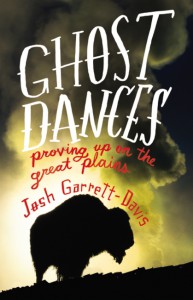 [Little, Brown and Company; 2012]
[Little, Brown and Company; 2012]
In the grand mythology of American history, the Great Plains are the symbol of opportunity and starting fresh, of success through rugged individualism. Yet the harsh climate and isolation have made it difficult for any one group to settle and stay for long: to “prove up,” in the terms of the 1862 Homestead Act. “Coming and going is the only thing native to the Plains,” Josh Garrett-Davis writes, which makes him a South Dakota native through-and-through. When he left for college on the East Coast, the author had every intention of leaving South Dakota behind in a cloud of dust; but the myth of the Plains kept calling him back. Ghost Dances: Proving Up on the Great Plains is a reckoning of Garrett-Davis’ troubled relationship to the land he called home but in which he never felt he belonged.
The book is part memoir and part landscape history, which makes for an idiosyncratic project. Garrett-Davis weaves the story of growing up feeling like an outsider in South Dakota with the tales of the various tribes, homesteaders, and intrepid individuals who lived and left the Plains. In Garrett-Davis’ repopulation of the Plains, there are teenage punks and American Indians, bison and hot-headed politicians. Tying all of these characters and stories into a cohesive narrative is not without its bumps and awkward transitions. It is Garrett-Davis’ obvious love for the place that propels the story forward, winding the prose around to another little-known fact or lushly described landscape, with a storyteller’s sense of direction.
“Now that I’m long gone from South Dakota,” Garrett-Davis writes in the opening chapter, “I would describe the mixed-grass prairie out the windshield as golden and singularly majestic, an ocean of fiber and rich carbohydrate, a subtle ecological masterpiece; back then it looked like dead brown straw.” Whether he is describing prairie grass or wagon trails, Garrett-Davis is always careful to catch himself before falling into nostalgia. The Plains are harsh, and the treatment of American Indians, natural resources, and bison has been equally menacing: it is not a place one can look back on with rose-colored glasses. Instead, Garrett-Davis shows the Plains with all its shortcomings, concluding his journey with hope for a less-bleak future that is powerful to read.
The book is divided into three parts, with the first focusing on his childhood in South Dakota and the history of the Plains; the second on the comings-and-goings of his early 20th century ancestors, a few of whom were minor celebrities then; and the third on creating a collection of mythologies about the Plains then, now, and for tomorrow. The first section is the strongest, with the second succumbing to slight nostalgia and the third to slight disorientation, but all three include fascinating first-hand accounts of the Plains.
Although Garrett-Davis admits it is a tricky metaphor, one of the best parallels in the book is the section which alternates between recounting the fallout of his parents’ custody battle over him and the custody battle over the fossil of Sue the T. Rex, unearthed in South Dakota in 1990. The parental legal battle determined whether the author, known just as Josh Davis then, would spend his teenage years in Portland with his lesbian mother or stay in South Dakota with his father. Too young to have much of a say in the ultimate decision, Garrett-Davis is nonetheless plagued by what-ifs and sees himself divided between belonging in the Plains and belonging on the Coast.
Sue had even less of an opinion on her relocation, and after drawn-out legalities regarding territory and the ownership of fossils, Sue resides today in the Field Museum of Natural History in Chicago. “All those places she could have ended up, where some argued she should have ended up, they haunt her.” Who is native and who belongs is not an easy question to answer, and it is a central theme of Ghost Dances. After recounting the tales of all those who at one point in history called themselves natives of the Plains, Garrett-Davis moves on to constructing the future of the Plains in the final section. He concludes with discussions of the utopian pipe dreams to “rewild” the Plains, or to alter the landscape so that it resembles what people have determined to be the natural state of the land. For some scholars that means bringing back the wild grasses and buffalo in their abundance before American settlers answered the call to go west; for others it means Pleistocene rewilding, or reverting the Plains completely to their state before 11,000 BCE. Although Garrett-Davis has worked through his own concerns about being a native of the Plains, the history of belonging to the Plains is still evolving.
Beyond Garrett-Davis’ personal goals for writing this book, he is also attempting to present this land as multifaceted and rich with history, as something more than flyover states. In both ways the book is a success. I admittedly read Ghost Dances as one who only had an airplane-view of the Plains, but the historical research Garrett-Davis presents is nuanced enough to entrance anew those who call themselves natives. The voices of Plains natives past and present call through time for readers to look more carefully at the history of a place they thought they knew.
This post may contain affiliate links.








